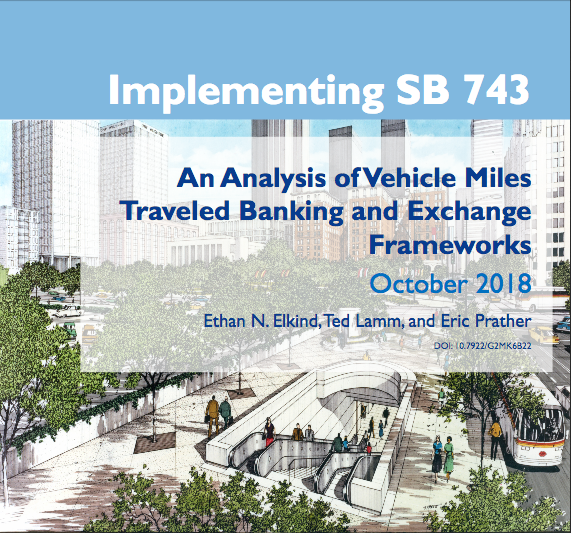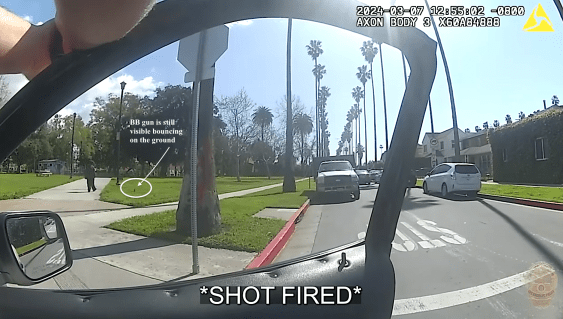Note: GJEL Accident Attorneys regularly sponsors coverage on Streetsblog San Francisco and Streetsblog California. Unless noted in the story, GJEL Accident Attorneys is not consulted for the content or editorial direction of the sponsored content.
A recently released report takes a deep look into a brand new way to handle mitigation under California's Environmental Quality Act (CEQA), one that could potentially benefit communities beyond the immediate vicinity of a particular development.
The concept, called “mitigation banks” or “exchanges,” would offer a way for developments that will create additional traffic, and can't figure out how to avoid it, to pay someone else to cut down driving in some other way. For example: a developer building a new mall may find that it would bring a lot of additional traffic; under CEQA, that new traffic would be an impact that would require mitigation for the project to proceed. A mitigation bank or exchange would allow the developer to pay into a fund that would be used to, say, improve or increase transit service in the surrounding community, thus helping decrease other nearby vehicle traffic.
The new idea is being explored in anticipation of final rulemaking, due to be released soon, on a major change to CEQA that Streetsblog has been nattering on about for years. That is, under S.B. 743, traffic delay—called Level of Service, or LOS—will no longer be considered an environmental impact, but instead the number of new vehicle miles traveled, or VMT—would be. This shift acknowledges that it is the amount of travel, not delay or congestion, that is the real environmental problem.
Using traffic delay as a proxy for environmental impact, as has been the practice under CEQA for years, has led to cities requiring developers to avoid delay by building wider, faster streets and intersections, which in turn has encouraged more driving. This has created communities that are hostile to people who don't drive, which is pretty much the exact opposite of an environmentally friendly or sustainable outcome.
Once the S.B. 743 rulemaking is complete, projects will have to estimate and mitigate for the new VMT they create, which is giving rise to conversations about what form that mitigation might take. Suggested remedies include transportation demand management programs, congestion pricing, and increased investment in infrastructure for transit, walking, and biking. Those may not be appropriate or even possible for a single developer to undertake—thus leading to the idea of creating a way to transfer or even share the work via a mitigation “bank” or “exchange.”
There are huge potential benefits as well as drawbacks to the idea. The just-released paper, Implementing S.B. 743: An Analysis of Vehicle Miles Traveled Banking and Exchange Frameworks, by Ethan Elkind, Ted Lamm, and Eric Prather of the UC Berkeley Center for Law, Energy, and the Environment, is a first stab at thinking through the policies, trade-offs, and legal considerations that would need to be discussed before setting up such a bank. The report was commissioned by the California State Transportation Agency (CalSTA) and supported with research funding from S.B. 1.
“The idea is not totally brand new,” said Elkind. “We have models, for example in offset markets and wetlands conservation.” Offset markets under cap-and-trade allow polluting industries to pay for something--say, for forest protection or a different company's emissions reductions—to earn credit towards meeting their emissions cap set by the cap-and-trade system. Similarly, contributing to the preservation and protection of wetlands in one place can sometimes make up for the paving over of another elsewhere.
The potential benefits to both developers and communities are many. “We could end up with a whole bunch of money to fund important infrastructure and other investments that reduce driving miles,” said Elkin. “For example, they could be a source of new money for transit, for bike lanes, for pedestrian walkways, or more car shares.”
One of the benefits for developers would be more certainty about whether they can bring a project into compliance. “A bank enables them to write a check,” so instead of having to figure out complex processes onsite, they could pay a transit company to improve or increase bus service.
The existence of a mitigation bank could also make it harder for an agency in charge of deciding whether to proceed with a project to issue a Statement of Overriding Consideration—basically, throwing up their hands in defeat when faced with increased travel from a development. A bank or exchange would give developers of even small parcels a concrete mitigation action they could take.
At the same time there are huge potential drawbacks inherent in the idea—including the same objections that have been raised about environmental offsets. That is, a developer could see it as a sort of “Get out of jail free card,” according to Elkind, where they could just write a check if they can't come up with any other solution.
Another potential problem, also shared with carbon offsets, is what Elkind refers to as “additionality.” Any bank or exchange would need to make sure that the funding it invested would actually produce new driving reductions—not ones that would have happened with or without the money. Ensuring the money isn't substituted for other sources of funding is very important. If a new source of funding for transit, for example, frees up other money that could then be spent on something else—like a road widening— “that would be a loss,” said Elkind.
While this is a tricky policy question, it's not without precedence. The Air Resources Board, for one, has had to come up with several ways to verify that emission reductions are being made as promised by program participants. The statewide Active Transportation Program also strives to verify that it is funding projects that otherwise wouldn't get built, and not just freeing up money for other projects.
Distance and jurisdiction are other important considerations. Should mitigation banks be local, city-run programs, or would it make more sense for them to be regional? Regional banks could be more flexible and could give rise to more widespread benefits, such as improved transit service. But if an area gets new sprawl development and “ends up paying with more traffic, and meanwhile money goes into a mitigation bank that funds transit elsewhere,” said Elkind, “that could become a political problem.”
“We have to think through the design of these exchanges,” he said. “We need to make sure we're not just letting developers off the hook for mitigations they could do onsite. We want to make sure developers are thinking about alternative project designs, not just paying an extra fee.”
The time scale is another consideration. If a new development were to help pay operating costs for transit, for example, how long would those payments last?
And, importantly, some kind of auditing mechanism is necessary. The paper recommends the creation of a uniform auditing scheme, said Elkind, “to make sure VMT reductions are [actually] happening. Otherwise, they will be enforced the same way everything else in CEQA is enforced--via lawsuits,” he added.
These details have yet to be worked out, but discussions have already begun among regional agencies and cities that are interested in pursuing the ideas laid out here. This report is a first step in establishing a legal and policy framework for what is a brand new way to invest in encouraging people to drive less. It is currently “a list of considerations,” said Elkind, “not a draft ordinance; it [describes] the considerations that need to be thought through before guidelines or standards are developed,” he said. “We probably missed a few.”
California is a pioneer in this area, but there is still a lot to work out. Once the S.B. 743 regulations are final, cities, counties, and regional agencies will be looking for ways to implement them, and the state wants to encourage them to consider mitigation banks or exchanges to make that easier. “A bank or exchange could make the process financial, instead of complicated case-by case mitigation” as happens currently, said Elkind. “Developers would be happier, and it could give locals a nice way to fund local projects,” he said.





